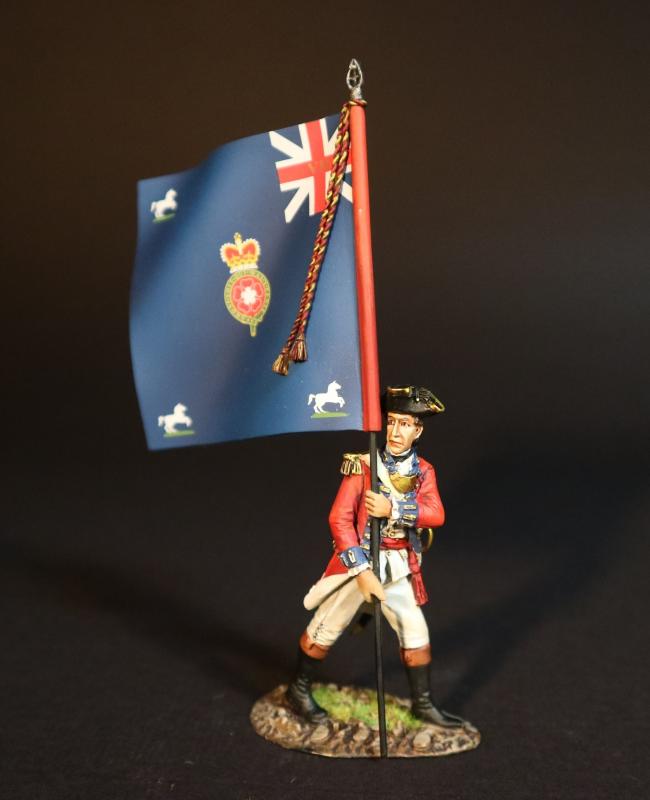Standard Bearer, 7th Regiment of Foot (Royal Fusiliers), The British Army, The Battle of Cowpens, January 17, 1781, The American War of Independence, 1775–1783--single figure with flag
$70.00
Item Number: CW7FL-02
Standard Bearer, 7th Regiment of Foot (Royal Fusiliers), The British Army, The Battle of Cowpens, January 17, 1781, The American War of Independence, 1775–1783
THE AMERICAN WAR OF INDEPENDENCE 1775 – 1783
THE BATTLE OF COWPENS, JANUARY 17th, 1781.
The Battle of Cowpens was an engagement during the American Revolutionary War fought on January 17th 1781, near the town of Cowpens, South Carolina, between American forces under Brigadier General Daniel Morgan, and British forces under Lieutenant Colonel Banastre Tarleton, as part of the campaign in the Carolinas. The battle was a turning point in the American reconquest of South Carolina from the British.
Tarleton’s force of 1,000 British troops were set against 2,000 troops under Morgan. Morgan’s forces suffered casualties of only 25 killed and 124 wounded. Tarleton’s force was almost completely eliminated with almost 30% casualties and 55% of his force captured or missing, with Tarleton himself and only about 200 British troops escaping.
Morgan’s forces conducted a double envelopment of the British forces, the only double envelopment of the war.
7th REGIMENT OF FOOT (ROYAL FUSILIERS)
The Royal Fusiliers were sent to Canada in April 1773. The regiment was broken up into detachments that served at Montreal, Quebec, Fort Chambly, and Fort St. Johns. In the face of the American invasion of Canada in 1775/76, the 80-man garrison of Fort Chambly attempted to resist a 400 man Rebel force, but ultimately had to surrender, losing its regimental colours as a result. The bulk of the regiment was captured when St. John’s fell.
A 70-man detachment under the command of Captain Humphrey Owens assisted with the Battle of Quebec in December 1775.
The men taken prisoner during the defence of Canada were exchanged in British-held New York city in December 1776. Here, the regiment was rebuilt and garrisoned New York and New Jersey. In October 1777, the 7th participated in the successful assaults on Fort Clinton and Fort Montgomery and the destruction of enemy stores at Continental Village. In late November, 1777, the regiment reinforced the garrison of Philadelphia. During the British evacuation back to New York City, the regiment participated in a diversionary raid in the days leading up to the Battle of Monmouth in June 1778.
In April 1780, the Royal Fusiliers took part in the capture of Charleston. Once Charleston fell, the regiment helped garrison the city. Three companies were sent to Ninety-Six to assist with the training of Loyalist militia companies. An 80-man detachment was also sent to Camden, South Carolina to help build that town’s defences. The detachments were recalled to Charleston for refitting in late August 1780.
The 7th, mounted on horses, along with the two regiments of Loyalist militia, cleared the region north of Georgetown, South Carolina of partisans while en route. The Royal Fusiliers turned the horses over to Lieutenant Colonel Banastre Tarleton’s British Legion upon uniting with Cornwallis in late September and then served as the Army’s rearguard.
Between October 1780 and early 1781, the regiment, having lost about one third of its officers and men to sickness and disease, protected the communication and supply lines between Camden and Winnsboro, South Carolina. On 7th January, 1781, a contingent of 171 men from the Royal Fusiliers was detached from Cornwallis’s Army and fought under the command of Tarleton at the Battle of Cowpens in January 1781.
The Royal Fusiliers were on the left of the line of battle: Tarleton was defeated and the regiment’s colours were once again captured, and stored in the baggage wagons.
A 19-man detachment from the regiment fought through North Carolina participating in the Battle of Guilford Court House in March 1781 and ultimately the siege of Yorktown, where it served with the regiment’s Light Infantry Company. There was another detachment, composed largely of men recovered from the hospitals and recruits, which remained in the South under the command of Lt. Col. Alured Clarke. These men remained in garrison in Charleston, until they were transferred to Savannah, Georgia in December 1781.
The regiment returned to England in 1783.
Released in JULY 2024.
